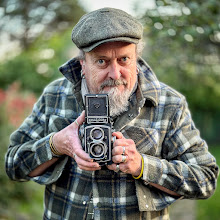Above: Ex Lancashire & Yorkshire Railway 'Pug' No. 51202 shunts the wharf sidings at Combwich in early October 1955.
Over the last couple of weeks I've been messing about with
Helicon Focus, the inexpensive layer stacking software, which when combined with photographs specifically taken for it can extend depth of field enourmously - in fact pretty well as much as you'd like!
The shot above was taken on a 'point and shoot'
Canon G9, one of the more recent relatively inexpensive small cameras aimed at the enthusiast photographer - of course any camera could be used, but I want to highlight the fact that you didn't need anything big and posh, because technique is the all important thing rather than kit.
At this level of closeup the loco is probably bigger on your screen here than in real life if you click on the image then select 'all sizes' to reveal a decent sized view. It's not going to be possible to get everything in focus; so by shooting a few identical frames, but focussed on key spots, and then with the aid of Helicon Focus to combine the images one can create a greater depth of field. For this particular shot, three identical photographs were taken, the first focussed on the buffers, the second on the cab, and the final on the rear of the red van. The software then takes care of the rest on the computer - simple!
The sky however was added in post production, it's far prettier than the wardrobe that was behind the section layout which was on the floor simply bathed in natural window light!
 Improvements this year for those who might have seen the layout before are improved brighter lighting, rejuvenated scenery, a traverser fiddle yard to replace the scary cassettes (scary because I could see a whole train becoming airborne all too easily) and a couple of extra items of rolling stock.
Improvements this year for those who might have seen the layout before are improved brighter lighting, rejuvenated scenery, a traverser fiddle yard to replace the scary cassettes (scary because I could see a whole train becoming airborne all too easily) and a couple of extra items of rolling stock.







Most digital still cameras now have the option of being able to record video, with some of the very latest cameras being potentially capable of outperforming conventional video cameras. Indeed, some of the new breed of DSLRs are used in commercial HDTV production, with the large sensor giving a narrow depth of field much like a 35mm motion pictures camera like an Arri - something that is very much favoured by drama producers.
The above short clip however doesn't get anywhere near HD or even low definition VHS, it simply being just a bit of fun to see if I can get a bit of movement onto the web.